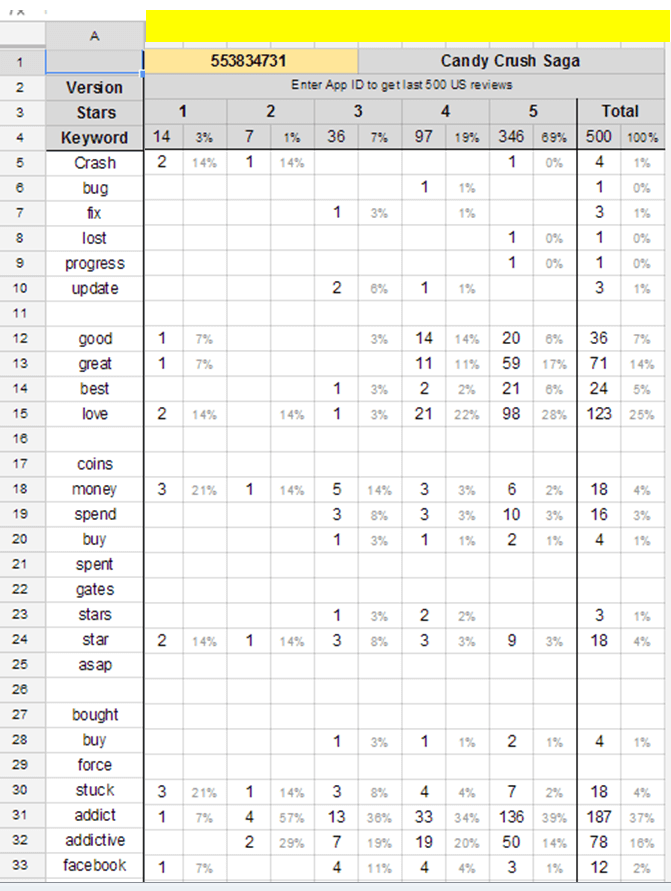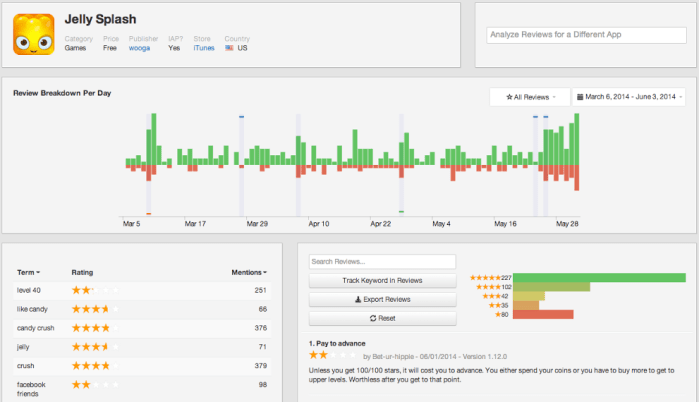How to Master the Most Important Off Page Factor in your App, besides the Downloads: App Reviews
Author: Evelin Ríos
How many companies, and not just in the applications industry, would say “no” to a substantial number of free, unsolicited user reviews?
Not many, right? Of course, we are talking about a very important factor in the success of an App, as are the users’ reviews and the hugely valuable information they contain.
Only the most progressive or the richest companies are investing in collecting more and better reviews.
Why only them? Maybe it’s because the perceived value of the reviews is too low. What can you learn from them? You cannot change them if they are bad, and there is no problem if they are good, so why bother?
This theory no longer makes sense, and here’s why.
GETTING A COMPETITIVE ADVANTAGE
The argument that is possibly more solid and simple to ignore the reviews is that there are literally millions of voices and they all tell you what they want in their applications. But the use of this vast amount of information has evolved into something incredibly useful.
We all know that the app markets are incredibly competitive places, and that we don’t get many opportunities unless we listen to the people who decide if it will be a success or not. It’s just common sense.
The use of reviews in the concept and prototype development phase of your application allows you to obtain a much clearer description of what the market wants.
Therefore, if you are creating a Saga-style puzzle game, for example, you could get reviews like this: “I cannot go through the barriers / doors. It’s so annoying! Removing the application.” You will see it several times, and after correlating some data, this notion will end up forming the basis of 30-40% of all negative criticism in the genre.
So, what do you do with this information?
Well, if you want to have happy users, it is probable that you need to direct your monetization efforts in other place other than “barriers/doors.”
Keep in mind that this is not something limited to games. In fact, for more functional applications, the analysis of reviews becomes easier, since in general the comments are much more specific.
UNDERSTANDING YOUR FAILURES
If you already have an application on Google Play or the App Store, you can analyse your reviews to determine your successes and failures. However, before starting to deepen your data, it is good to establish points of reference.
While app reviews are a very important factor for its visibility among so many options, it is also important that you know how users find Apps in the app stores.
One of the most interesting discoveries we can make is that when analysing the reviews of applications in the top of downloads of the stores, we can see that they have an extremely low number of negative reviews. That figure varies between 7% and 1%, but the average is around 4.5%.
When you begin to look further down the list, the ratings begin to be much more varied. In those of average level that have had some success, you begin to see negative rates of between 30% and 75%. Therefore, this not only has an impact on the user’s perception, it also has an effect on the positioning algorithm and is an important metric for decision making.
So simply in terms of monetization, it is worth taking a good look at the ratings and opinions of your application to deal with the problems that your users are experiencing.
SENTIMENT ANALYSIS: THE NEW METRIC
It is not enough simply to look at the amount of positive and negative comments. We must analyze in detail what the users say and, if possible, group these comments to create an idea of the feeling that they transmit.
Although perhaps this is not so easy to understand and do, at the most basic level, it involves grouping themes using keywords that may be more meaningful to us.
Gathering the type of information you can see below can help you prioritize the problems that really matter to your users.

In this example we see the importance of resolving technical problems before those regarding cost
GENERATING KEYWORDS
Another element that is often overlooked in the analysis of ratings or reviews is the generation of keywords.
You can find many keywords in them, and one of the best ways to discover those hidden gems that all Apps optimizers love is to track positive reviews in the genre or category they’re working on.
This is something that even small developers can take advantage of because they are more likely to find very specific keywords that have less competition.
One of the most important aspects when writing the description of your application is to make sure that you are speaking to your audience in terms that they can easily understand. This is very easy to do by taking a look at the reviews.
An example that comes from games is that very often you will see the words ‘addict’, ‘great’, ‘love’ and ‘cute’ in the game reviews. But do you want to include those terms in your keywords? Probably not all, but both ‘cute’ and ‘addict’ seem to be highly under-used keywords.
Obviously, this is something that is more or less valid depending on the type of application being developed, as well as the marketing expense behind it.
OBTAINING THE DATA
Basic Method
Knowing what to do with this information is one thing, but knowing how to find all that juicy information is quite another.
The first and slowest way to obtain this information is manually.
Both Google and Apple allow us to filter and see opinions from the most useful, most crtical, most favorable to the most recent. We can also filter by the most recent version or in general. It is advisable to consider the latest version, particularly with larger applications.
These refining parameters are almost enough to gather decent data, luckily, which makes it a viable option for a smaller developer, or for those who are just beginning to analyze reviews.
This method has certain advantages. Ultimately, the reviews are qualitative in nature, and this method allows you to understand more at the individual level.
Also, if you are just learning about review analysis, it will give you a good understanding of the inherent problems in more complex ways of doing things.
Organized Method
The problem with manual review analysis is that it takes a long time to collect and analyze data. This is not really suitable for developers who want to keep up with what is happening in the industry.
If you want to analyze reviews regularly, a good option is to create your own review analysis tool.
As a developer, this is something that can be done relatively easily. This can be more or less complex according to your ability to create, or you can simply create an Excel spreadsheet that allows you to copy and paste comments from sources like AppAnnie and break them down on a general level.

A simple Excel sheet can provide you with a great view of your app’s reviews
Automized Method
Two of the best products on the market to automate this process are the SensorTower and AppAnnie business packages, but there are also other interesting tools, such as Apptopia and MobileAction.
Without going into detail about them, they are platforms that provide a set of tools that help to obtain better visibility in the entire application ecosystem.
The real advantage is that they offer very robust review analysis tools, as well as ASO professionals that help guide you through the process, the results and the action points.
With these tools you can quickly and easily control the language and sentiment of people who review applications directly in the app store. You can also get direct comparisons with your competition, which gives you an excellent point of reference.

A quick look at the review análisis tool SensorTower
The only drawback of these powerful tools are their prices. These can be expensive, especially if you already have other elements of the business packages they offer.
A few thousand euros a month just for a review analysis tool is hard to justify. However, the combination of this with localization elements and the in-depth knowledge offered by an ASO expert can be much more in line with your budget.
Review analysis, while not yet essential for the mobile application industry, can be incredibly useful for generating keywords, analyzing languages and feelings and evaluating competition.
It is also something that can help you understand why your App does not work as well as it should.
Ultimately, the reviews are there for one reason. The reason is to improve the applications and offer a more personalized experience to all users.
From a personal point of view, we hope that the Apps reviews are an important part of the Apps Stores and provide a real indication of the value of an application.
We firmly believe that those who are ahead of the game in terms of review analysis have many more possibilities to create applications that reach the top and remain there.

